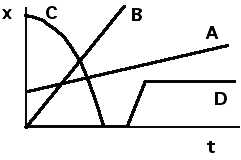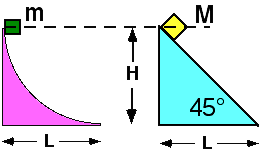Two masses, m and M, are released from rest at a height H above the
ground. Mass m slides down a curved surface while M slides down an
incline as shown. Both surfaces are frictionless and M > m.
Which of the following statements is true?
- The time it takes for m to reach the end of the surface is longer because the path it takes is longer.
- The time it takes is the same since both masses are released from the same height.
- The time it takes for M to reach the end of the incline is less because its horizontal acceleration is larger.
- The time it takes for m to reach the end of the surface is shorter because it has a larger acceleration initially and therefore builds speed more quickly.
- The time it takes is the same since both masses have the same displacement.
- The time it takes is the same because both masses have the same speed at the end.
- The times cannot be compared without knowing the masses of the blocks.
- More than one statement above is correct
- None of the above statements is correct.




Commentary:
Answer
(2); This question seems difficult but it is available
to beginning students. Students can analyze the problem considering the
entire toy as a single system or decompose into the separate masses.
Viewed as a single system, since the center of mass accelerates up, the
net force must point up. Free body diagrams for each mass individually
would show no net force on the bottom mass (because the normal force
assumes a value necessary to balance gravity and spring force) and a
large net force on the upper mass (spring force exceeds gravity). If
sketched to scale, the two can be added showing that the net force
derives from the normal force on the lower block.
Background
This question is intended to have students distinguish between internal
and external forces. The question also can be approached in a variety
of ways.
Questions to Reveal Student Reasoning
Can the toy ever leave the surface? Would there be a net force if it
did leave the surface?